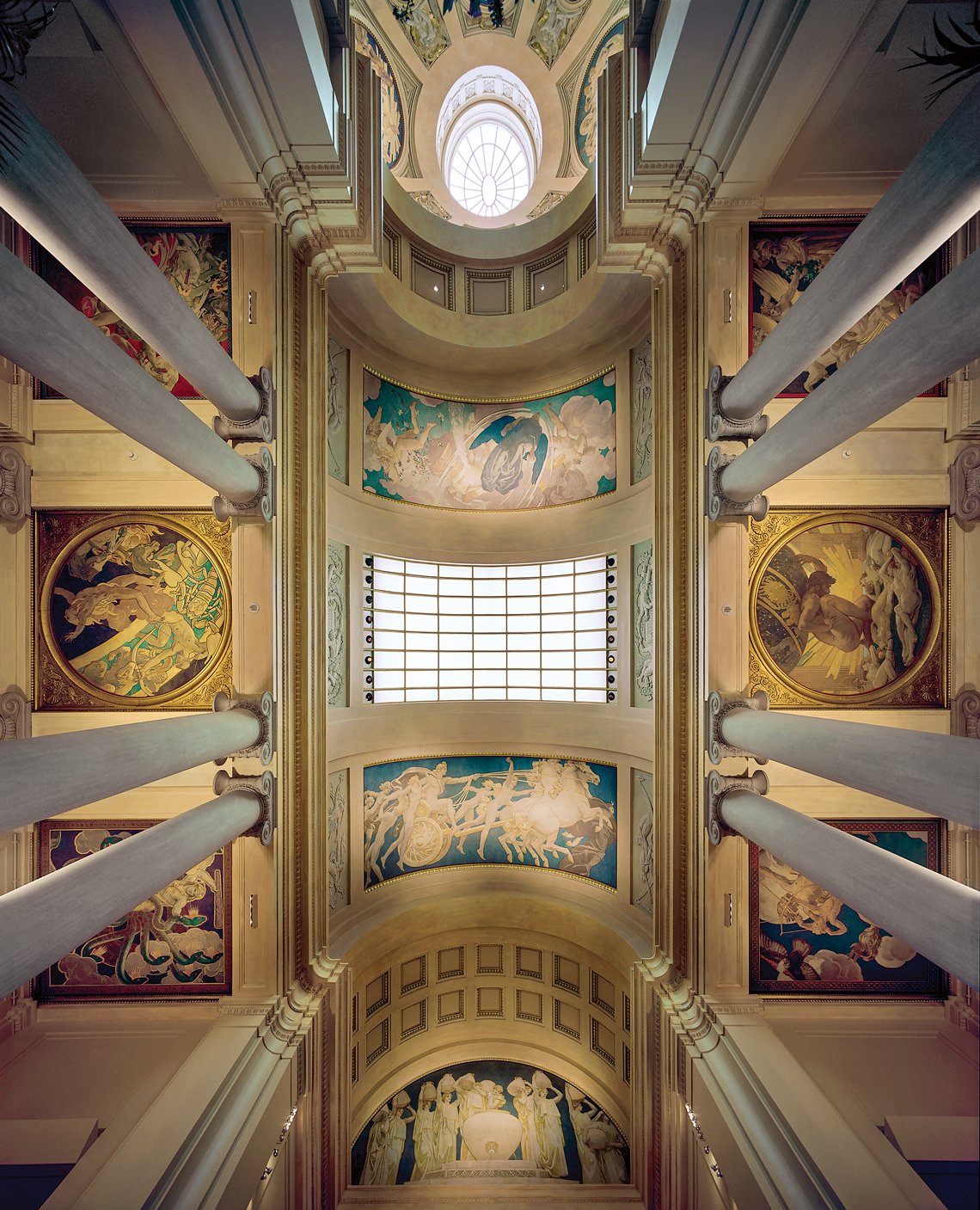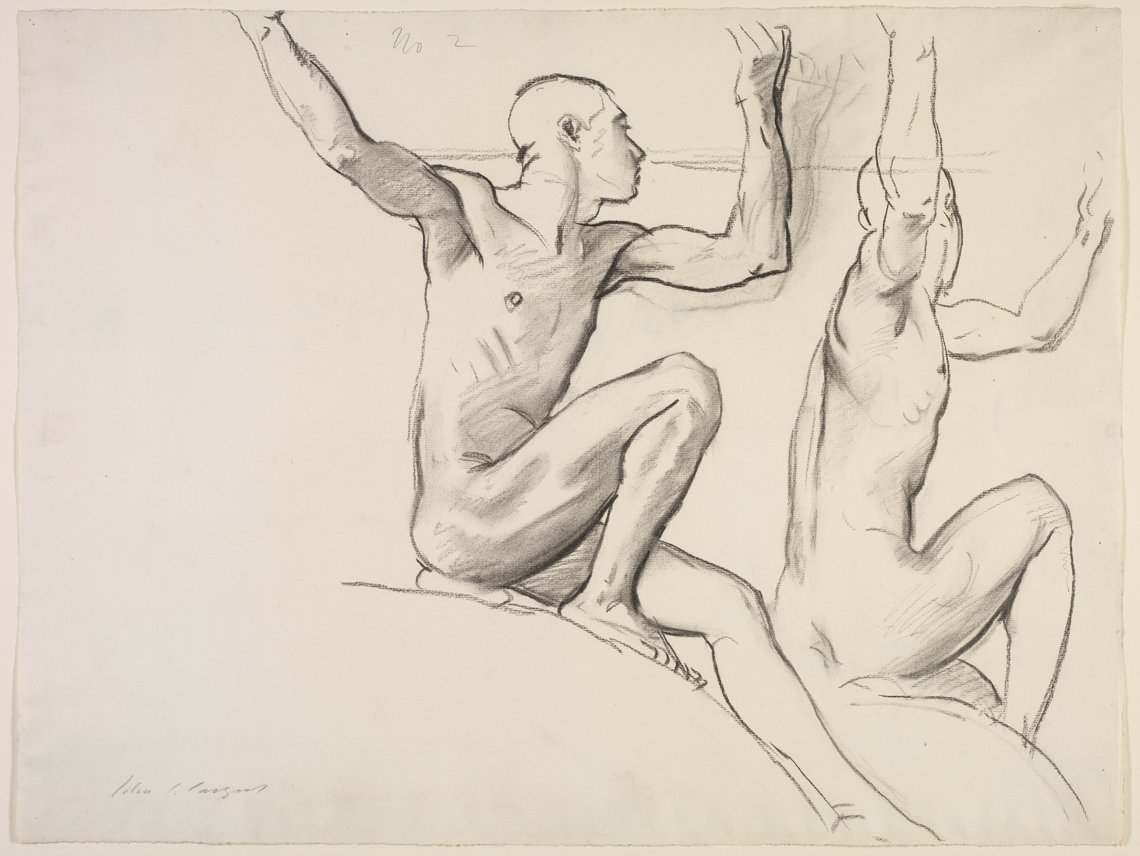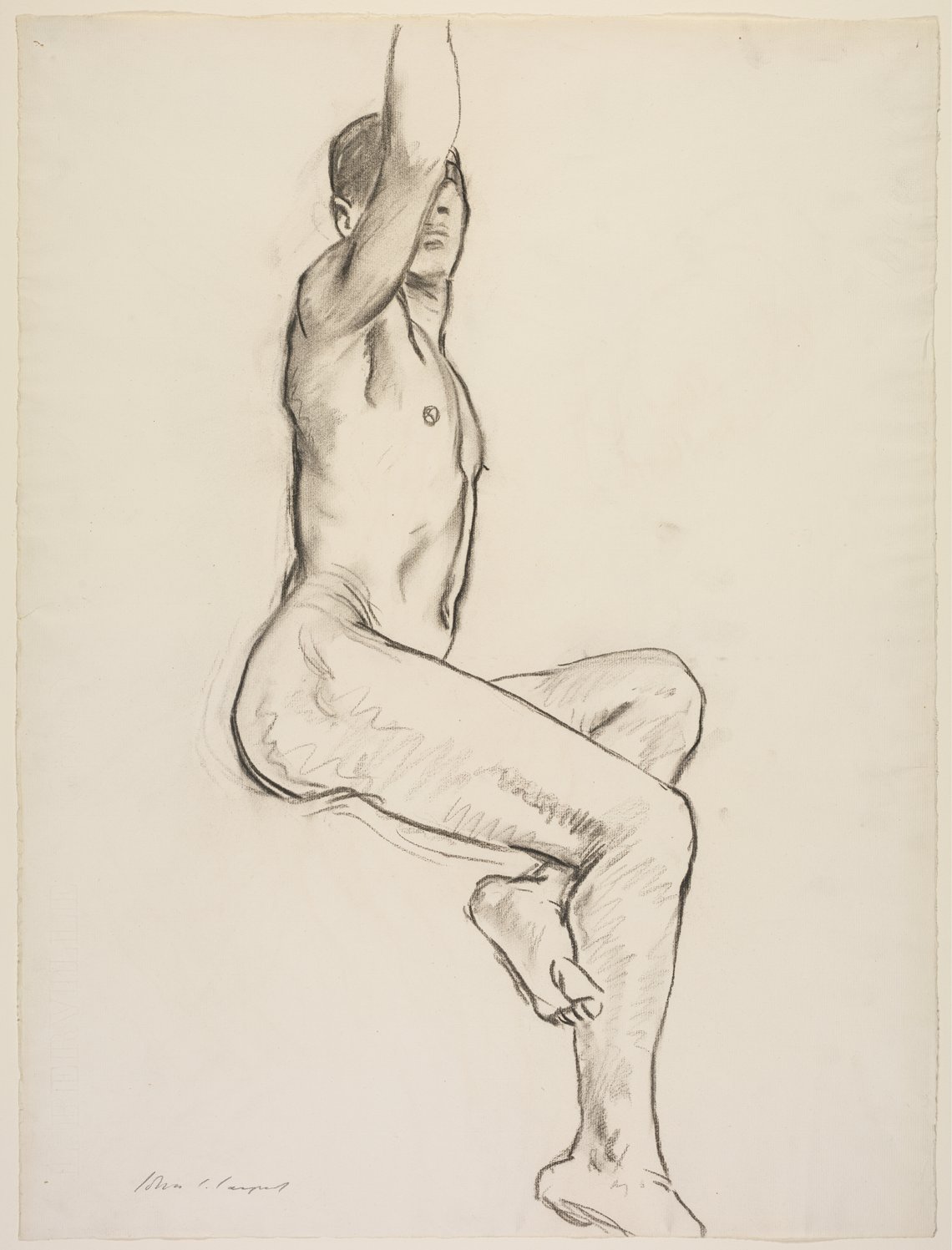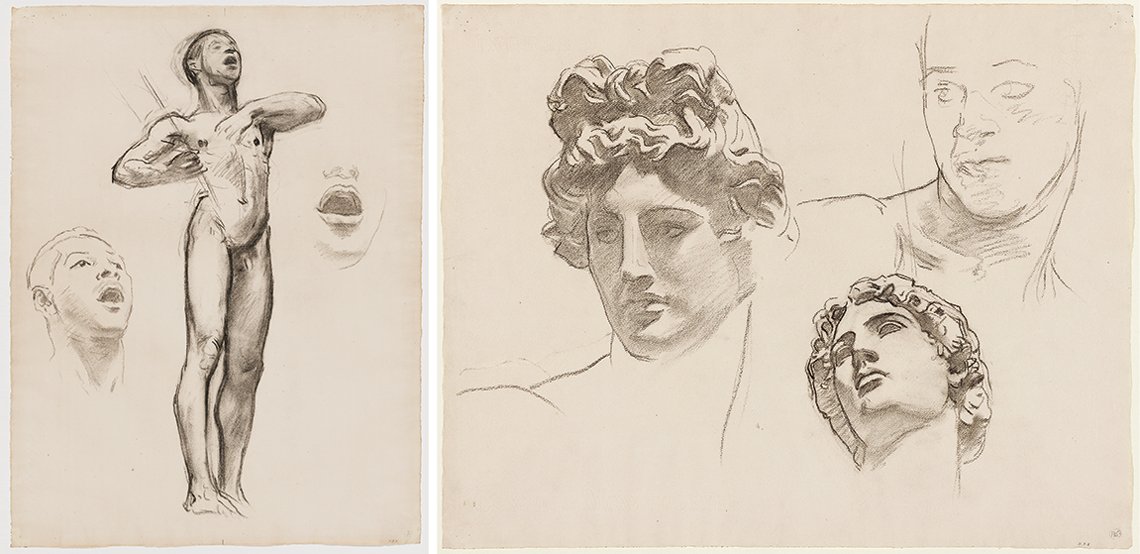Boston’s Apollo: Thomas McKeller and John Singer Sargent
Thomas McKeller (1890–1962), a Black elevator operator, WWI veteran, and artist’s model, bore witness to some of the most brutal events in America’s history. As a child, he experienced a massacre of the Black citizens of his hometown Wilmington, N.C., and the subsequent introduction of Jim Crow segregation laws, and never lived to see their abolition. As a teenager, he joined the Great Migration, arriving in Boston and finding employment at the Hotel Vendome, where a chance encounter brought him face-to-face with painter John Singer Sargent (1856–1925). McKeller subsequently became Sargent’s principal model in this country. Two murals—at the Museum of Fine Arts, Boston, and Harvard University—as well as drawings and a full-length nude painting memorialize nearly a decade of work in the artist’s studio, where Sargent transformed McKeller into Apollo—god of the arts—as well as into goddesses, allegories, soldiers, and more. The painter gifted a portfolio of these drawings to his friend and patron Isabella Stewart Gardner (1840–1924).
 |
The Rotunda of the Museum of Fine Arts, Boston, with murals by John Singer Sargent, 1916–1921. Photograph © 2019 Museum of Fine Arts, Boston. In 1916, John Singer Sargent arrived in Boston for his first visit in thirteen years. A local celebrity and one of America’s most renowned painters, he was increasingly preoccupied with his artistic legacy and set aside portraiture for murals: monumental public works that could secure his posthumous fame. Trustees of the city’s Museum of Fine Arts invited him to decorate the interior of the entrance to their new building in Boston’s Fenway. Sargent’s ambitious proposal reimagined the rotunda as a shrine to the arts of antiquity. The museum accepted, paying him $40,000 for the project. Unveiled in 1921, Sargent’s rotunda met with staggering success. |
 | |
The Stairway and Side Aisles of the Museum of Fine Arts, Boston with murals by John Singer Sargent, 1922–1925. Photograph © 2019 Museum of Fine Arts, Boston. |
This exhibition, Boston’s Apollo: Thomas McKeller and John Singer Sargent, shares Sargent’s drawings and McKeller’s story for the first time, exploring the intersection of McKeller’s model’s life with that of Sargent and Gardner. In the process it raises many questions as relevant then as they are today. How did history erase a man who played such a pivotal role in Boston’s public art? What were the dynamics of this artist-model relationship and how was it shaped by race and class? Was this a purely professional association or a personal one too? Many voices—including the museum’s community collaborators, McKeller’s contemporaries, and a member of his family—contributed their thoughts and encourage viewers to reflect on the relevance of this story in today’s world.
The opening gallery is dedicated to Thomas McKeller’s life. Images of the works of art he modelled for—the Museum of Fine Arts murals, the Widener Library murals at Harvard, a portrait of the university’s president for whom he modelled the body, and an over life-size bronze statue of the Wampanoag satchem Massasoit—signal how much unknown history underpins these images. Together they share space with cases of archival material, including correspondence in McKeller’s own hand and notes from David McKibbin’s interview with him. A timeline covers the facing wall, setting dates from McKeller’s life alongside those of Boston’s pioneering Black citizens and events related to them. This gallery concludes with a film by Helga Davis, the museum’s visiting curator of performing arts, who interviewed many participants of this project, including McKeller’s great niece and the daughter-in-law of his best friend.
 | |
John Singer Sargent (American, 1856–1925), Study of Two Male Nudes for a Cartouche for the Rotunda of the Museum of Fine Arts, Boston, 1916–1921. Charcoal on paper, 18-3/4 x 24-7/8 in. Isabella Stewart Gardner Museum, Boston (S.G.Sar.4.1.2). Poised on a cushion with arms raised, Thomas McKeller poses for pairs of nude figures modeled in plaster relief above the rotunda’s four roundels. These sculpted images have no individual identities but collectively celebrate the figurative arts and the bodies they depend on. |
The main gallery features the drawings of McKeller given to Gardner by John Singer Sargent, displayed together for the first time. Bold and dynamic, these rapid charcoal sketches show McKeller adopting complex poses for Sargent, who then worked through different mythological subjects. Two additional studies—on loan from the Museum of Fine Arts, Boston—reveal how Sargent transformed one Black man into the many porcelain-white figures that fill the MFA’s ceiling mural.
This gallery concludes with the only known portrait of McKeller, a full-length nude oil painting on loan from the MFA. Sargent probably conceived this striking image as a study. He eventually abandoned the painting’s original purpose, completing it as an independent work and hanging the framed canvas in his studio, where it memorialized nearly a decade of work with McKeller. The painting may have even inspired Beaufort Delaney’s (1901–1979) portrait of James Baldwin, titled Dark Rapture, a reproduction of which appears in the same space. Visitors are invited to share their own thoughts and post them on a nearby bulletin board.
 |  |  | ||
Left: John Singer Sargent (American, 1856–1925), Study of a Seated Male Nude for the Rotunda or Grand Staircase of the Museum of Fine Arts, Boston, 1916–1921. Charcoal on paper, 24-15⁄16 x 18-13⁄16 in. Isabella Stewart Gardner Museum, Boston (S.G.Sar.4.1.3). Seated on a stool with one arm outstretched, McKeller tilts his body off-center and gazes downward. The relationship of this drawing to the murals remains unclear, but it may be an early study for Perseus or a rider such as Arion or Achilles. Center: John Singer Sargent (American, 1856–1925), Study of a Seated Male Nude for the Rotunda or Grand Staircase of the Museum of Fine Arts, Boston, 1916–1921. Charcoal on paper, 25 x 18-3/4 in. Isabella Stewart Gardner Museum, Boston (S.G.Sar.4.1.4) Sargent captures McKeller in sharp profile, likely during a session devoted to modeling the rotunda’s pairs of nude figures sculpted in plaster. In addition to his face, a birthmark or flap of skin protruding from his chest and visible in other drawings identifies the sitter as McKeller. Right: John Singer Sargent (American, 1856–1925), Study of a Seated Male Nude above a Roundel for the Rotunda of the Museum of Fine Arts, Boston, 1916–1921. Charcoal on paper, 24-15⁄16 x 18-7/8 in. Isabella Stewart Gardner Museum, Boston (S.G.Sar.4.1.5). With quick and confident charcoal marks, Sargent captures McKeller’s face in profile and traces the contours of his muscular arms. Like the others in this series, McKeller’s pose does not correspond to a single painted or sculpted figure in the rotunda. Below, Sargent sketches the contours of the rotunda and one of its cartouche frames in profile. | ||||
 |
John Singer Sargent (American, 1856–1925), Study for Eros and Psyche for the Rotunda of the Museum of Fine Arts, Boston, 1916–1921. Charcoal on paper, 18-7/8 x 24-13⁄16 in. Isabella Stewart Gardner Museum, Boston (S.G.Sar.4.1.6). Thomas McKeller modeled this figure for a rotunda relief, featuring Eros, who plunged out of the heavens and into Psyche’s arms, literally falling in love. Sargent focuses here on McKeller’s muscular legs and shapely torso, reserving the poses of his arms and head for other studies. |
 |
John Singer Sargent (American, 1856–1925), Chiron and Achilles, 1921. Oil on canvas, 137 x 125 in. Museum of Fine Arts, Boston (25.644). Photograph © 2019 Museum of Fine Arts, Boston. In this sketch, the young Achilles is balanced on the centaur Chiron and draws back his bow to fire an arrow. Half man, half horse, Chiron—the adopted son of Apollo—mentored Greek hero Achilles in the arts of war and peace. Here, Sargent focuses on the twisting backs of each torso, eventually abandoning this approach for a frontal arrangement as seen in the companion image, Chiron and Achilles. |
 |
John Singer Sargent (American, 1856–1925), Study for Chiron and Achilles for the Rotunda of the Museum of Fine Arts, Boston, 1916–1921. Charcoal on paper, 18-7/8 x 24-13⁄16 in. Isabella Stewart Gardner Museum, Boston (S.G.Sar.4.1.7) |
 |
Left: John Singer Sargent (American, 1856–1925), Study for Apollo in Classic and Romantic Art for the Rotunda of the Museum of Fine Arts, Boston, 1916–1921. Charoal on paper, 18-11⁄16 x 24-5/8 in. Museum of Fine Arts, Boston (28.633). Photograph © 2019 Museum of Fine Arts, Boston. McKeller stands erect in this study, raising his head in song. Sargent envisioned this allegory of Classic and Romantic Art as a singing contest, here making detailed studies of McKeller’s face. In the finished roundel, he replaced the model’s head with one from a classical statue but retained the open-mouthed expression. Sargent’s transformation of McKeller into Apollo emerges clearly on this sheet. Beginning at the top right, he sketches the model’s head and neck. Below, the artist copies the god’s head from a plaster cast of the Apollo Belvedere, a celebrated Roman sculpture. At the far left, he replaces McKeller’s head with the sculpture’s and places it on the model’s shoulders. The painted mural above incorporates the results of the transformations from these sketches. |
 |
John Singer Sargent (American, 1856–1925), Classic and Romantic Art, 1921. Oil on canvas, 100-3/8 x 167 in. Museum of Fine Arts, Boston (21.10514). Photograph © 2019 Museum of Fine Arts, Boston. |
 |
John Singer Sargent (American, 1856–1925), Thomas McKeller, 1917–1921. Oil on canvas, 49-1/2 x 33-1/4 in. Museum of Fine Arts, Boston (1986.60). Photograph © 2019 Museum of Fine Arts, Boston. Born in Wilmington, North Carolina, in 1890, Thomas Eugene McKeller moved to Boston in his mid-teens. Segregation in Boston was at the time enforced socially and economically rather than legally. Sargent probably initiated this painting as a study for one of the roundels in the Museum of Fine Arts murals. Beginning to the left, Sargent blocks out the model’s body on canvas and surrounds him with wings, perhaps the remnants of an abandoned idea to depict Prometheus with the eagle that attacked him in punishment for the titan’s theft of fire from the gods. No ordinary nude, this painting stands out in Sargent’s oeuvre, elevating the academic practice of figure studies to the level of portraiture. |
 |
Boston’s Apollos: Thomas McKeller and John Singer Sargent , is on view at the Isabella Stewart Gardner Museum, Boston, Mass., through October 12, 2020, in the Hostetter Gallery. For information, visit gardnermuseum.org or call 617.566.1401.
Nathaniel Silver is the William and Lia Poorvu Curator of Collections, Isabella Stewart Gardner Museum, Boston, Mass.
This article was originally published in the Autumn 2020 issue of Antiques & Fine Art magazine, a fully digitized version of which is available at www.afamag.com. AFA is affiliated with Incollect.com.
 |































